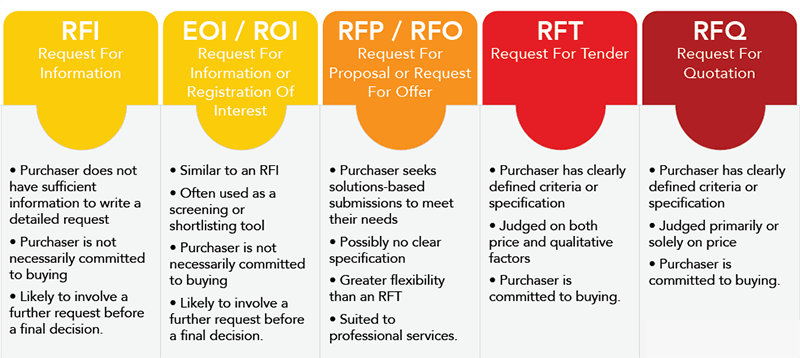Mastering Procurement Acronyms: Understanding of RFI, RFQ, and RFP
Unravel the mystery of procurement acronyms with this comprehensive guide to RFI, RFQ, and RFP. Take your procurement knowledge to the next level!
Procurement requests are a critical component of strategic sourcing and purchasing initiatives for businesses. Understanding the role of these documents during each phase of the procure-to-pay or source-to-pay process is a key step in designing an optimal and autonomous sourcing workflow. While large procurement operations often involve a multitude of different ‘request’ formats – the distinctions between Request for Information (RFI), Request for Quotation (RFQ), and Request for Proposal (RFP) are essential for any modern procurement team.
Request for Information (RFI)
Request for Information (RFI) is a formal document used by organizations to gather information and details from potential suppliers or vendors about their products, services, and capabilities. The primary purpose of an RFI is to collect basic information to evaluate suppliers before moving to the next stage of the procurement process. For suppliers, getting an RFI is an important first step in landing new customers.
RFIs typically include questions related to a supplier’s qualifications, experience, financial stability, and other relevant criteria. By issuing an RFI, organizations can pre-qualify suppliers and narrow down the pool of potential vendors for further evaluation.
Key elements found in an RFI may include the company background, proposed solution, pricing information, references, and any specific requirements from the buyer. The benefits of issuing an RFI include gaining insights into potential suppliers’ capabilities, understanding market offerings, and streamlining the supplier selection process.
Subscribe to news from Arkestro.
No spam, just relevant procurement news and tips. You can unsubscribe at any time.
Request for Quotation (RFQ)
Request for Quotation (RFQ) is a solicitation document used to gather pricing information and quotations from suppliers for specific products or services. RFQs are typically more detailed than RFIs and focus on obtaining competitive pricing bids from suppliers.
RFQs differ from RFIs and RFPs in that they specifically request pricing details for the goods or services being procured. Key components of an RFQ include a detailed list of items or services required, quantities, specifications, delivery terms, and any contractual terms and conditions.
The advantages of using an RFQ in procurement operations include facilitating price comparisons, encouraging competitive bidding, and ensuring transparency in the purchasing process. RFQs help organizations secure the best value for their procurement needs.
Request for Proposal (RFP)
Request for Proposal (RFP) is a comprehensive document that outlines the buyer’s requirements, specifications, and evaluation criteria for a particular project or procurement need. RFPs are used when the procurement process requires detailed proposals from suppliers, including technical solutions and pricing.
RFPs are more complex than RFIs and RFQs and often involve a formal evaluation process to assess supplier proposals against predefined criteria. Key elements typically included in an RFP are project scope, deliverables, evaluation criteria, terms and conditions, and pricing structure. In manufacturing operations RFPs are used for everything from packaging to transportation and freight.
Utilizing an RFP in strategic sourcing allows organizations to evaluate suppliers based on their capabilities, proposed solutions, and overall suitability for the project. RFPs help ensure that procurement decisions are made based on a thorough analysis of supplier proposals, not just pricing.
Key Differences Between RFI, RFQ, and RFP
RFI, RFQ, and RFP serve distinct purposes in the procurement process. RFIs are used for preliminary information gathering and supplier qualification. RFQs focus on pricing and obtaining competitive bids, while RFPs are detailed documents that solicit comprehensive proposals from suppliers.
Understanding when to use an RFI, RFQ, or RFP is critical in strategic sourcing. RFIs are typically used at the beginning of the supplier selection process to gather basic information. RFQs are employed when pricing information is a primary consideration, and RFPs are utilized for complex procurement needs that require detailed proposals.
Conclusion
Mastering the distinctions between RFI, RFQ, and RFP is essential for effective procurement and strategic sourcing. By leveraging the unique benefits of each type of procurement request, organizations can streamline their purchasing processes, make informed supplier selection decisions, and ultimately drive value for their business.
Ready to optimize your strategic sourcing process? Take the next step and contact us or request a demo to learn how Predictive Procurement Orchestration can help you quickly identify quotes that may be problematic – saving you time and money!
FAQs
Understanding Procurement Acronyms
-
What is an RFI in procurement?
An RFI (Request for Information) is a document used to gather general information about products, services, or suppliers. It helps in understanding market capabilities and potential solutions before initiating a formal procurement process.
-
How does an RFQ differ from an RFI?
An RFQ (Request for Quotation) is more specific than an RFI. It requests detailed pricing information and terms for a specific product or service. RFQs are used when the requirements are well-defined.
-
What is an RFP and when is it used?
An RFP (Request for Proposal) is a document requesting detailed proposals from suppliers to deliver specific products or services. It includes requirements, criteria for selection, and evaluation methodology. RFPs are used for complex projects where multiple solutions are possible.
-
Why are these documents important in procurement?
These documents streamline the procurement process, ensuring clear communication, competitive pricing, and suitable solutions. They help organizations make informed decisions and select the best suppliers.
-
How do RFI, RFQ, and RFP work together?
Typically, the process begins with an RFI to gather information, followed by an RFQ to obtain pricing, and finally an RFP to solicit detailed proposals. This sequential approach helps in thorough evaluation and informed decision-making.

